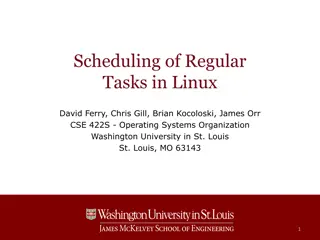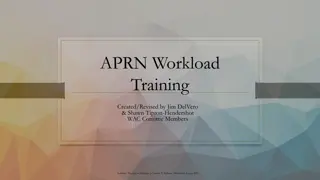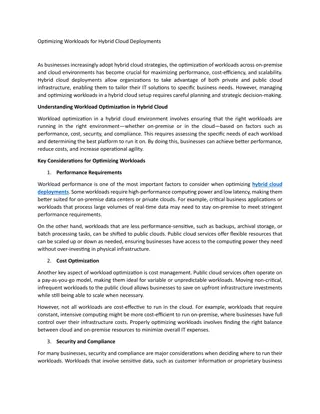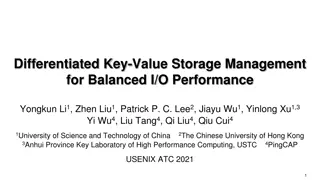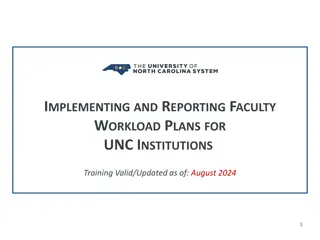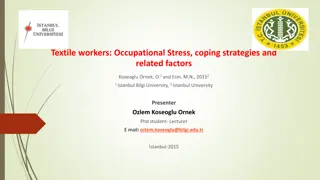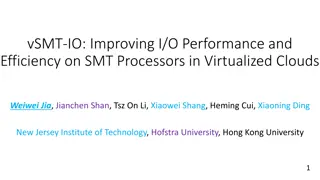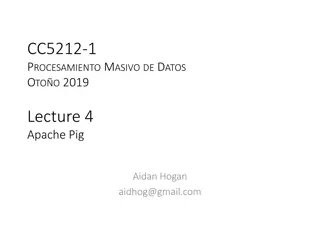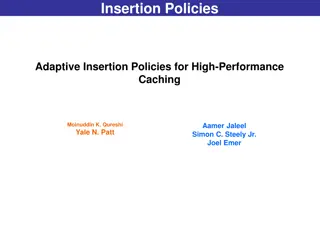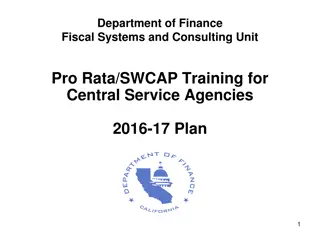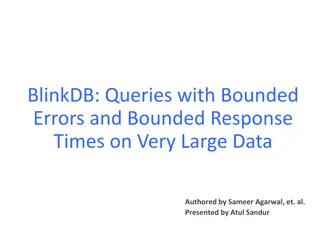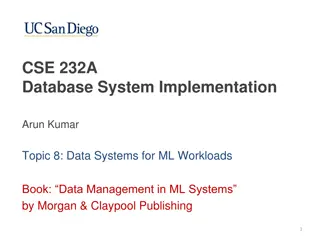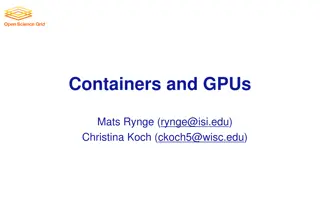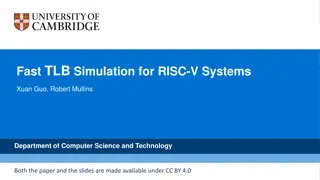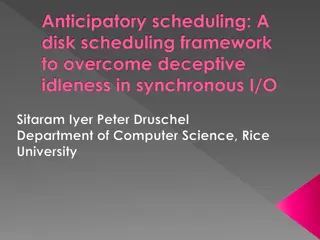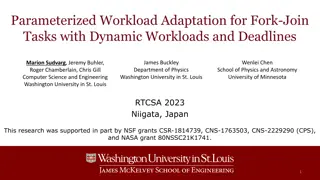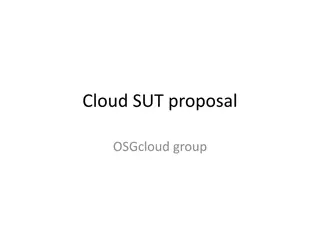Azure IoT Edge
Seamlessly move cloud and custom workloads to the edge securely. Deploy AI and advanced analytics with ease. Monitor and update from the cloud. Azure IoT Edge provides a secure and scalable solution from chipset to the cloud.
0 views • 16 slides
Understanding Linux Process Scheduling and Priorities
Delve into the intricacies of process scheduling in Linux systems, covering topics such as task prioritization, process states, scheduler decisions, and important scheduling scenarios. Learn about traditional scheduling concerns like throughput and latency, as well as different types of workloads su
3 views • 19 slides
Network Function Abstraction A delicate question of (CPU) affinity?
Exploring the delicate balance of CPU affinity in network function abstraction, including challenges, benefits, and solutions like CPU pinning for network workloads. Learn about the impact on performance and scalability, as well as the importance of proper configuration in virtual and physical envir
3 views • 40 slides
APRN Workload Training
Article 14 highlights the importance of addressing excessive workload in nursing units for quality patient care and staff satisfaction. A workload review committee is established to provide education, resources, and data analysis related to staffing, scheduling, and workload management. The new APRN
0 views • 17 slides
Understanding Stress and Coping Strategies
Understanding the nature and impact of stress is crucial in managing it effectively. Stress is a common experience with various physiological, physical, psychological, and behavioral effects. Coping strategies are essential to deal with stressors such as anxiety, overdrive, and constant stress facto
0 views • 17 slides
Understanding Chain Replication for High Throughput Object Storage
Chain replication is a technique used to achieve high throughput and scalability in object storage systems. It ensures strong consistency by maintaining replicas of data across a chain of nodes, enabling efficient read-mostly workloads. The approach simplifies programming complexity and enhances sys
0 views • 28 slides
Trends in Computer Organization and Architecture
This content delves into various aspects of computer organization and architecture, covering topics such as multicore computers, alternative chip organization, Intel hardware trends, processor trends, power consumption projections, and performance effects of multiple cores. It also discusses the sca
5 views • 28 slides
Safety Standards Development and Implementation Plan Overview
Overview and plan details regarding the development and implementation of safety standards post-2026/2027 within the existing long-term structure. Includes medium-term plan, estimated workloads for committees, and ongoing safety standard developments. The document outlines strategies, review of exis
4 views • 15 slides
Optimizing Workloads for Hybrid Cloud Deployments
As businesses increasingly adopt hybrid cloud strategies, the optimization of workloads across on-premise and cloud environments has become crucial for maximizing performance, cost-efficiency, and scalability.
0 views • 2 slides
SIP Overload Control Strategies for Efficient Network Management
This content discusses the importance of overload control in SIP networks to manage excessive loads, high response times, and ineffective workloads. It explores strategies such as SIP Rate Control, Nodal Overload Control, and Destination Overload Control for improving network performance. The conten
0 views • 8 slides
Managing Large Graphs on Multi-Cores with Graph Awareness
This research discusses the challenges in managing large graphs on multi-core systems and introduces Grace, an in-memory graph management and processing system with optimizations for graph-specific and multi-core-specific operations. The system keeps the entire graph in memory in smaller parts and p
0 views • 14 slides
Balanced I/O Performance Through Differentiated Key-Value Storage Management
Real-world workloads are diverse, requiring key-value storage systems to efficiently handle varying value sizes and types of operations. This paper introduces DiffKV, a system that optimizes I/O performance by managing keys and values with different ordering strategies, fine-grained separation, and
1 views • 17 slides
UNC Faculty Workload Policy Training Overview
This training focuses on implementing and reporting faculty workload plans for UNC institutions based on Policy 400.3.4 and Regulation 400.3.4[R]. It covers the purpose, definitions, significant dates, best practices, requirements, and institutional reporting related to faculty workload. The objecti
0 views • 18 slides
PELICAN: A Building Block for Exascale Cold Data Storage
PELICAN addresses the need for cost-effective storage of cold data in the cloud, offering exabyte-scale storage solutions. By provision resources specifically for cold data workloads, it optimizes storage efficiency and reduces unnecessary resources, resulting in high-density, low-cost storage with
0 views • 30 slides
Occupational Stress Among Textile Workers: Coping Strategies and Gender Differences
The textile sector in Turkey employs a large number of workers, predominantly women, who face high levels of occupational stress due to poor working conditions, low pay, and demanding workloads. This stress results from a mismatch between job demands and employee capabilities, leading to negative im
0 views • 25 slides
Enhancing I/O Performance on SMT Processors in Cloud Environments
Improving I/O performance and efficiency on Simultaneous Multi-Threading (SMT) processors in virtualized clouds is crucial for maximizing system throughput and resource utilization. The vSMT-IO approach focuses on efficiently scheduling I/O workloads on SMT CPUs by making them "dormant" on hardware
0 views • 31 slides
Wander Join: Online Aggregation via Random Walks in Database Workloads
Wander Join is a technique for online aggregation using random walks, addressing challenges in efficiency and correctness in both transactional and analytical database workloads. It allows for complex analytical queries such as TPC-H queries and provides insights into revenue loss due to returned or
0 views • 27 slides
Fast Multicore Key-Value Storage Study
Explore Cache Craftiness for Fast Multicore Key-Value Storage in a comprehensive study on building a high-performance KV store system. Learn about the feature wishlist, challenges with hard workloads, initial attempts with binary trees, and advancements with Masstree. Discover the contributions and
0 views • 38 slides
Cloud Load Balancing Overview and Requirements
This content provides a detailed overview of cloud-scale load balancing, involving components like servers, hypervisors, VMs, VIPs, DIPs, and the role of load balancers in distributing workloads efficiently. It also discusses communication flows involving VIPs, DIPs, front-end VMs, back-end VMs, and
0 views • 35 slides
Managing DRAM Latency Divergence in Irregular GPGPU Applications
Addressing memory latency challenges in irregular GPGPU applications, this study explores techniques like warp-aware memory scheduling and GPU memory controller optimization to reduce DRAM latency divergence. The research delves into the impact of SIMD lanes, coalescers, and warp-aware scheduling on
0 views • 33 slides
Energy-Efficient GPU Design with Spatio-Temporal Shared-Thread Speculative Adders
Explore the significance of GPUs in modern systems, with emphasis on their widespread adoption and performance improvements over the years. The focus is on the need for low-power adders in GPUs due to high arithmetic intensity in GPU workloads.
0 views • 46 slides
Processing Big Data with Apache Pig in Hadoop Ecosystem
Explore how Apache Pig can be utilized in the Hadoop ecosystem to process large-scale data efficiently. Learn about concepts such as handling multiple inputs, job chaining, setting reducers, and utilizing a distributed cache. Compare Hadoop with SQL and understand why SQL might not be suitable for l
0 views • 78 slides
Dynamic Partial-Parallel Data Layout for Efficient Video Surveillance Storage
Addressing the energy consumption challenge in video surveillance storage, a Dynamic Partial-Parallel Data Layout (DPPDL) is proposed to handle fluctuating workloads efficiently. By dynamically adjusting parallelism and ensuring chronological data deletion, the system aims to optimize performance an
0 views • 13 slides
The World of Azure Database Offerings
Exploring Azure's database offerings including Azure Cosmos DB and Azure SQL Database. Azure Cosmos DB provides a globally scalable document database solution, while Azure SQL Database is a great option for SQL Server workloads. Both platforms offer unique features such as low latency, scalability,
0 views • 15 slides
Chi: A Scalable and Programmable Control Plane for Distributed Stream Processing
Distributed stream processing systems are increasingly crucial for various production use cases, such as real-time dashboards, machine learning, and interactive debugging. The challenges of handling large variability in production ingestion workloads and high-degree data skew in queries are addresse
1 views • 20 slides
Adaptive Insertion Policies for High-Performance Caching
Explore the concept of adaptive insertion policies in high-performance caching systems, focusing on mitigating the issue of Dead on Arrival (DoA) lines by making simple changes to cache insertion policies. Understanding cache replacement components, victim selection, and insertion policy can signifi
0 views • 15 slides
Neuromorphic Computing: Bridging the Gap Between Silicon and Human Cognition
This research delves into neuromorphic computing, a cutting-edge field that merges principles from biology and silicon technology to advance cognitive processing. The study explores top-down approaches, drawing inspiration from the auditory cortex for DNS, and bottom-up strategies to enhance CPU arc
0 views • 17 slides
Central Service Agencies Cost Allocation Training Plan
This training plan by the Department of Finance's Fiscal Systems and Consulting Unit focuses on understanding Central Service Agency costs, cost allocation plan development, workload spreadsheets, data analysis, and due dates. It covers the definition of workloads, expenditures, and centralized serv
0 views • 51 slides
Study on Burnout Levels Among Practicing RNs in New York
Research conducted by the Center for Health Workforce Studies examines burnout levels among practicing Registered Nurses (RNs) in New York. Findings highlight factors contributing to RN burnout, such as demanding workloads and stressful environments, impacting job performance and patient care qualit
0 views • 23 slides
Family Support Policies and Flexible Working Policy at The School of Biological Sciences
The School of Biological Sciences at the University of Edinburgh has local policies supporting family needs and flexible working arrangements. These policies include parental leave cover, workload expectations upon return from parental leave, and flexible working options. The school ensures that sta
0 views • 7 slides
Overview of BlinkDB: Query Optimization for Very Large Data
BlinkDB is a framework built on Apache Hive, designed to support interactive SQL-like aggregate queries over massive datasets. It creates and maintains samples from data for fast, approximate query answers, supporting various aggregate functions with error bounds. The architecture includes modules f
0 views • 26 slides
Data Systems for Machine Learning Workloads and Advanced Analytics
This content explores the intersection of database systems with machine learning workloads, covering topics such as big data systems, ML lifecycle tasks, popular forms of ML, and data management concerns in ML systems. It delves into the importance of ML systems for mathematically advanced data anal
0 views • 21 slides
Achieving Bounded Latency in Data Centers: A Comprehensive Study
Data centers face challenges in providing consistent low latencies due to in-network interference and varying workloads. This study explores solutions to guarantee strong latency performance, mitigate latency variance, and minimize performance degradation for latency-sensitive applications. By analy
0 views • 18 slides
Understanding Containers and GPUs for Efficient Computing
Discover the power of Graphical Processing Units (GPUs) and how they can be harnessed through containers for parallelized workloads in tasks such as deep learning, molecular dynamics, and number crunching. Learn about GPU use cases, managing GPU jobs, requesting GPUs, and the benefits of using conta
0 views • 21 slides
Architectural Support for Effective Data Compression in Irregular Applications
Irregular applications, such as graph analytics and sparse linear algebra, are memory-bound workloads. This paper discusses the challenges of compressing data structures in irregular applications, focusing on specialized hardware to accelerate data access and decompression. The study highlights the
0 views • 26 slides
Fast TLB Simulation for RISC-V Systems - Research Overview
TLB simulator for RISC-V systems introduced to evaluate TLB designs with realistic workloads, focusing on performance rather than cycle accuracy. The design sacrifices some accuracy for improved performance, making it suitable for meaningful software validation and profiling tasks.
0 views • 29 slides
Overcoming Deceptive Idleness with Anticipatory Scheduling
Addressing the issue of deceptive idleness in disk scheduling by implementing an anticipatory scheduling framework that leverages prefetching and anticipation core logic. This framework enhances the efficiency of handling synchronous I/O processes to prevent premature decision-making by the schedule
0 views • 21 slides
Understanding Professional Staff Workloads and the E7 Form Process
This presentation provides essential information on professional staff workloads, the importance of the E7 form, and the process involved in defining job duties and responsibilities. It outlines the role of the E7 form in detailing job descriptions, the need for annual review and potential revisions
0 views • 20 slides
Parameterized Workload Adaptation for Fork-Join Tasks with Dynamic Workloads and Deadlines
In dynamic environments, tasks may face unknown workloads and deadlines, leading to system overload and missed deadlines. This research focuses on adapting task workloads to provide results before the deadline by adjusting computational parameters. It explores how to minimize degradation of result u
0 views • 31 slides
Exploring Cloud SUTs: Characteristics, Metrics & Potential Workloads
Delve into the world of Cloud SUTs with a focus on understanding the diverse characteristics, key metrics, and potential workloads/use cases. Uncover the challenges of defining SUTs in cloud offerings and explore various classifications such as virtualized, non-virtualized, and mixed environments. G
0 views • 15 slides

